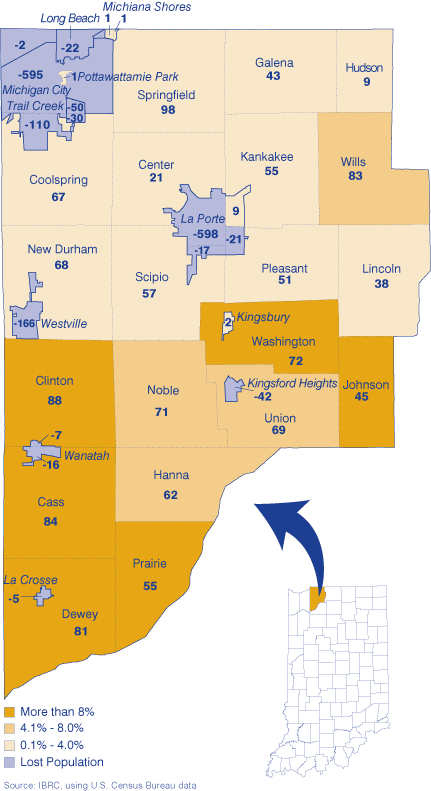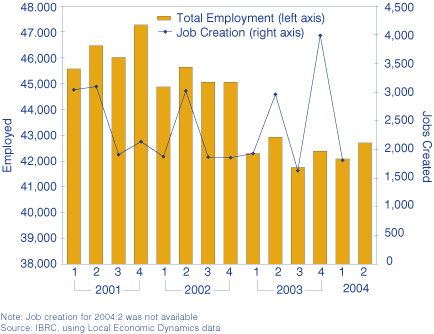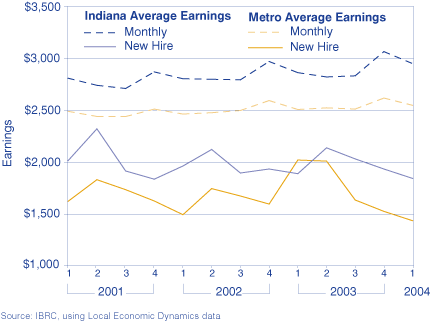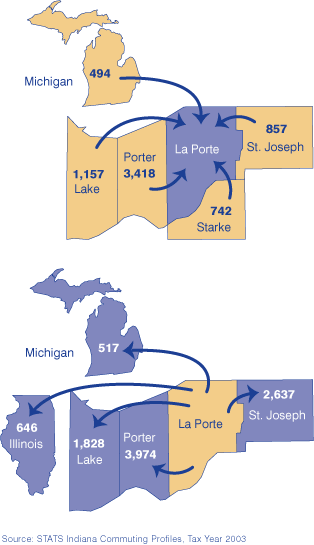The Michigan City-La Porte Metro Area
Along Indiana’s northwest urbanized corridor, the Michigan City–La Porte Metropolitan Statistical Area (metro) consists solely of La Porte County, between the Gary metro division and the South Bend–Mishawaka metro. With a 2004 population of 109,755, it is significantly smaller than its neighboring metros, and is the fourth smallest metro in the state. From a single county perspective, however, La Porte is the 15th largest Hoosier county.
Almost 30 percent of the county population (32,179) reside in Michigan City, the state’s 24th largest city. Another 19 percent (20,982) live within the La Porte city limits. Westville, Trail Creek and Long Beach are a few of the other smaller communities found in the metro.
During the past four years (2000–2004), La Porte County has lost 0.4 percent of its population, or 450 people. Its cities and towns lost a total of 1,665 people, ranging from a 705-person decline in Michigan City to a two-person gain in Kingsbury. Population loss in the city coupled with growth in the unincorporated areas is a trend throughout the state (1), and La Porte County is no exception. Figure 1 shows the change in population between the cities and the township balances, where the unincorporated areas gained 1,215 people (a 2.8 percent growth). Moreover, one can quite clearly see that population growth is concentrated in the southern half of the county, both numerically and on a percentage basis.
Figure 1: Change in Population, 2000 to 2004

Population projections from the Indiana Business Research Center indicate that, by 2020, the Michigan City–La Porte metro will grow 2.3 percent (about 2,500 people) from current levels. This is significantly slower than the state’s anticipated growth of 8.1 percent. The area is expected to have about 5,000 more senior citizens than it did in Census 2000. The growth rate of 34.1 percent for those 65 and older is slower than the state’s anticipated growth of 40.6 percent. However, the metro has a slightly older population to begin with and by 2020, nearly 18 percent of the population will be in the upper age group.
Industrial Mix and Jobs
The Michigan City–La Porte metro’s largest sectors include manufacturing (20.5 percent), health care (13.1 percent) and retail trade (12.5 percent). These are all slightly more dominant than in the state as a whole, as of the fourth quarter of 2004.
Major employers in the region include Blue Chip Casino, La Porte Hospital, St. Anthony Memorial Health Center, Weil-McLain (boilers and water heaters), Sullair (air compressors, dryers and filters) and Trans-Apparel (clothing).
Using the Local Employment Dynamics (LED) data from the U.S. Census Bureau, we see that total employment has dropped off in recent years, for a total of 42,702 in the second quarter of 2004 (see Figure 2). Job creation has hovered around 2,000 per quarter during the past several years, excluding the second quarter cyclical spikes in hiring. While the fourth quarter of 2003 saw a huge jump in hiring, the number of jobs created in the first quarter of 2004 (1,812) is lower than the same quarter in previous years.
Figure 2: Metro Employment and Job Creation, 2001 to 2004

Commuting
According to the preliminary commuting data for 2003, over 7,500 people commute into La Porte County to work, while almost 10,900 residents commute out of the county (see Figure 3). More than 75 percent of commuters who leave the county work in Porter, St. Joseph or Lake County. Another 11 percent cross state lines for job opportunities near Chicago or southwestern Michigan.
Figure 3: La Porte Commuters, 2003
Wages and Compensation
Overall, the average weekly wage for La Porte County was $619, or $87 less than the state average, for the fourth quarter of 2004. The five highest paying industries include
- Management of Companies and Enterprises, $1,085
- Manufacturing, $839
- Construction, $825
- Wholesale Trade, $781
- Transportation and Warehousing, $764
Wages for all sectors were lower than the Indiana average, except for construction and transportation and warehousing, where La Porte surpassed the state’s average weekly wage by $2 and $13, respectively. The biggest gap occurred in the professional, scientific and technical services, where the La Porte workers earned about $300 less per week than their counterparts in other areas of the state. (2)
The LED data set allows us to look at the average monthly wage compared to that of new hires. Figure 4 shows that the metro has fluctuated in sync with the state during the past several years, albeit at lower wage levels. For the first quarter of 2004, the average monthly wage in Michigan City–La Porte was $2,547, while the average new hire earned $1,436.
Figure 4: Average Monthly and New Hire Wages, 2001 to 2004

Changing our view now and looking at total compensation, which includes employer contributions to pensions and insurance, we find the average annual compensation in La Porte for 2003 (the most current data available) was $35,630. Employer contributions to pension and insurance funds in La Porte grew 24 percent, while wages grew just 0.5 percent between 2001 and 2003. This compares to a 39 percent growth in pension and insurance contributions and a 4 percent increase in salaries and wages at the state level, where the average compensation per job was $41,415.
Notes
- This phenomenon was addressed in an article in the July issue, Beyond
the Limits: Significant Population Gains Occur Outside Cities and Towns;
available online at
www.incontext.indiana.edu/2005/july/4.html. - Mining technically had the largest gap ($425) between state and regional weekly wages. However, mining is a very small part of the local economy, accounting for just 38 jobs and 0.1 percent of the local workforce.
Rachel Justis, Managing Editor
Indiana Business Research Center, Kelley School of
Business, Indiana University

